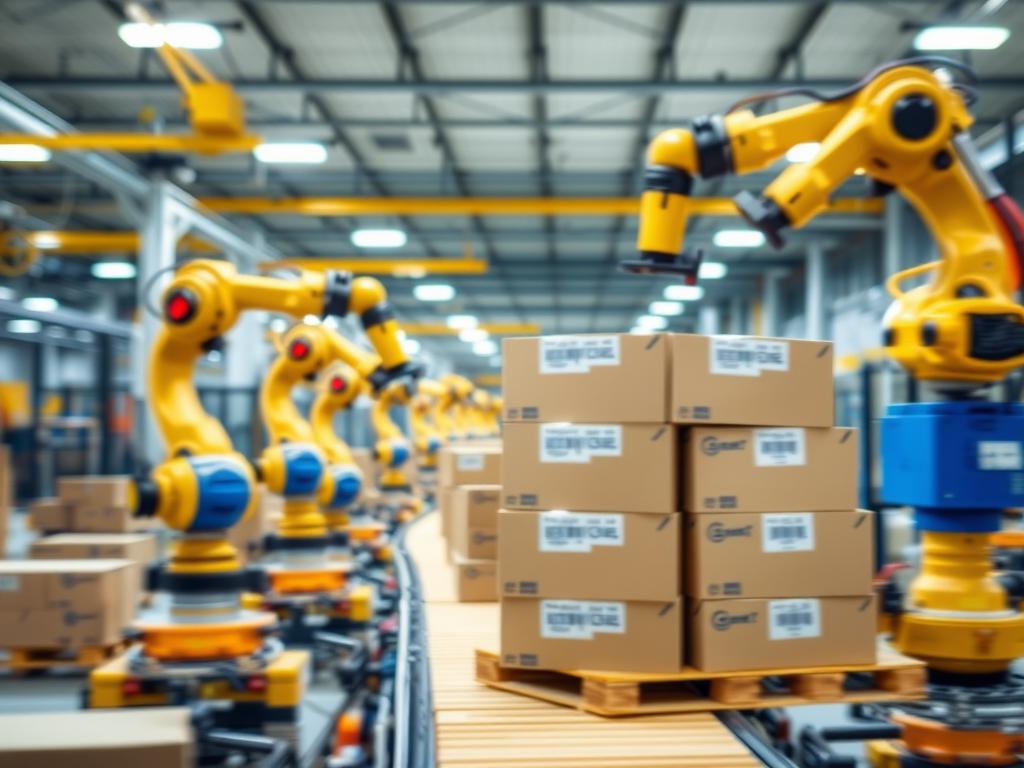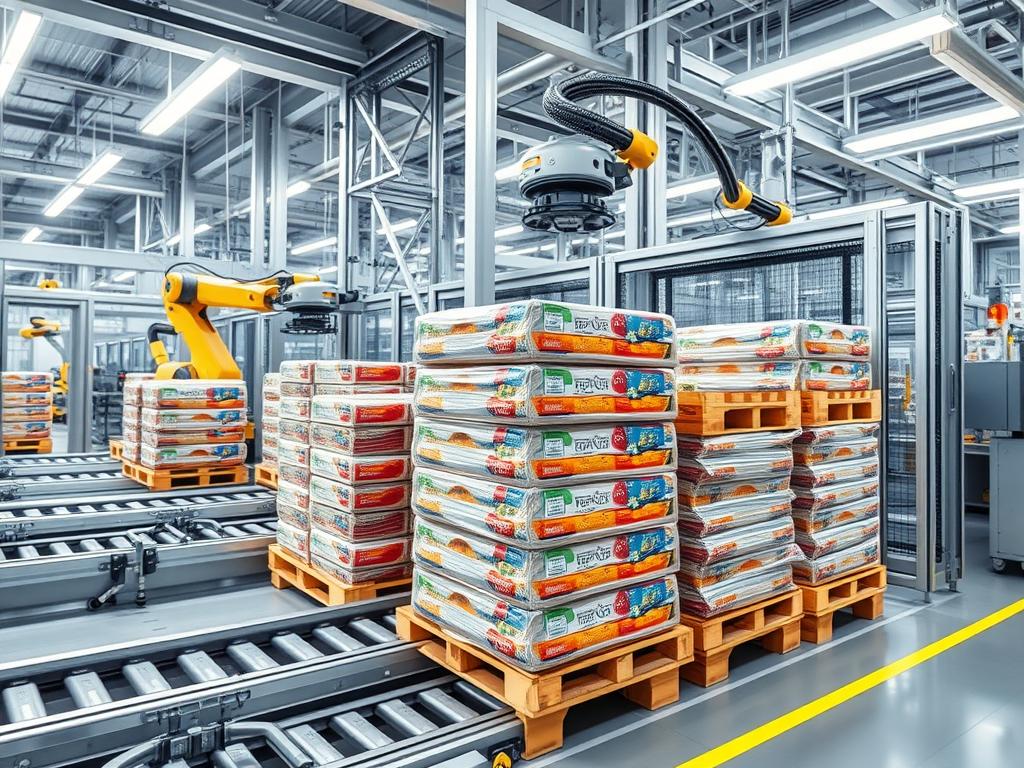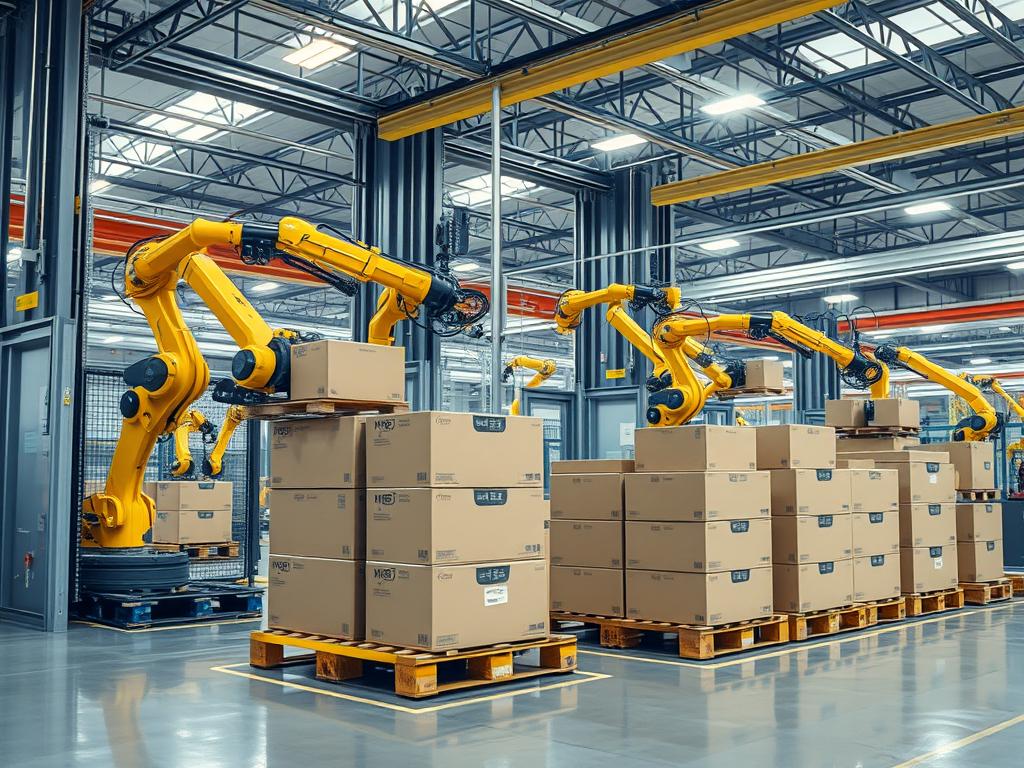In global manufacturing, one robot exists for every 71 humans. This highlights the rapid adoption of automation across industries. Palletizing automation is reshaping warehouse operations and setting new efficiency standards.
Manual palletizing faces challenges like labor shortages and ergonomic issues. Automated palletizing systems offer a solution to these problems. They streamline tasks, ensure efficient product grouping, and guarantee safe transport.
Warehouse automation through palletizing brings many benefits. It improves storage, transport, safety, and productivity. These systems can handle various products and offer long-term cost savings.
This guide explores palletizing automation’s importance in modern logistics. We’ll look at its integration with new technologies and its benefits to warehouse operations.
We’ll examine how robotic palletizers and collaborative solutions are changing industries. These systems are creating smarter, more efficient logistics processes. Learn how to optimize your operations with palletizing excellence.
Understanding Palletizing Automation
Palletizing automation revolutionizes warehouse operations. It boosts efficiency and safety in product handling. This technology transforms how items are stacked for shipping.
What is Palletizing Automation?
Palletizing automation uses advanced systems to stack products on pallets. Robotic palletizers work non-stop, increasing output and reducing mistakes.
These systems adapt to various product sizes and shapes. They ensure optimal use of pallet space.

Key Components of Palletizing Systems
Automated palletizing systems comprise several crucial elements:
- Robotic arms for precise product placement
- Conveyor systems for smooth product flow
- Intelligent software for optimal stacking patterns
- End-of-Arm Tooling (EOAT) for secure product handling
These parts work together for efficient pallet handling. The system’s flexibility allows quick changes for different products.
It can handle various pallet configurations with ease.
Benefits of Implementing Palletizing Automation
Automatic pallet loading systems offer many advantages:
| Benefit | Impact |
|---|---|
| Increased Efficiency | 24/7 operation, boosting throughput |
| Improved Safety | Reduced workplace injuries from manual handling |
| Enhanced Accuracy | Consistent stacking patterns, minimized errors |
| Cost Savings | Long-term reduction in labor costs and product damage |
Palletizing automation integrates smoothly with existing systems. It ensures smooth operations and real-time data processing.
This technology’s scalability makes it ideal for growing businesses. It helps optimize logistics processes effectively.
Industries Transformed by Palletizing Automation
Palletizing automation has revolutionized various sectors, boosting efficiency and productivity. Pallet stacking robots are changing the game in food processing and pharmaceuticals. Let’s explore how different industries benefit from this technology.
Food and Beverage Sector
In food and beverage, palletizing cells handle diverse packaging with ease. These systems can process 17 cases per minute, taking just 3.5 seconds per case. They manage up to 19 different box types, stacking layers of 11 boxes max.
This speed ensures fresh goods move quickly from production to distribution. Efficient handling is crucial for maintaining product quality in this industry.

E-commerce and Retail Applications
E-commerce thrives on rapid order fulfillment. Automated palletizing systems adapt to varying product sizes, crucial for online retail. In consumer goods, automation cut operator needs from 14 to 3 per shift.
Portable solutions can handle 600 boxes hourly, with products up to 40 lbs. This flexibility is essential for e-commerce’s diverse product range.
Pharmaceuticals and Healthcare
The pharmaceutical industry relies on precise handling and sterile environments. Industry-specific automation in this sector ensures accuracy and safety. Robotic systems complete one pallet before switching, allowing time to replace full pallets without interruption.
| Industry | Key Benefit | Performance Metric |
|---|---|---|
| Food & Beverage | Rapid Processing | 17 cases/minute |
| E-commerce | Adaptability | 600 boxes/hour |
| Pharmaceuticals | Precision | 100% accuracy |
Palletizing automation boosts throughput and minimizes product damage across industries. It also enhances inventory management in various sectors. With continuous operation and improved accuracy, these systems are transforming operations everywhere.
Practical Applications of Palletizing Automation
Palletizing automation has transformed many industries. It offers efficient solutions for handling products. Pallet loading machines are now crucial in streamlining operations across sectors.
Case Study: Automotive Industry
The automotive sector uses automated pallet formation for heavy components. FANUC’s M-410iC/110 palletizer achieves up to 2200 cycles per hour. One FANUC M-410iB robot can do the work of four humans.
Robotics in Palletizing
Robotic palletizers offer great flexibility in handling different products. They can be programmed for complex stacking patterns. These systems take up less space than traditional conveyor-based setups.

Custom Solutions for Different Needs
Custom palletizing solutions cater to specific industry requirements. Companies like Midwest Engineered Systems offer specialized systems for various product types. The beverage industry needs high-speed applications, while electronics assembly requires precision handling.
“By 2030, enterprises that don’t transition to circular business models emphasizing recycling and reusing packaging may risk losing competitiveness.” – World Economic Forum
Automated palletizing systems provide cost-effective solutions and improved flexibility. They adapt easily to new products. AI and 5G technology integration will further transform supply chains.
These systems offer greater efficiency and productivity gains. They are set to revolutionize industries in the future.
Challenges in Palletizing Automation
Palletizing automation offers great benefits but comes with challenges. Businesses face obstacles when switching to automated systems. These include financial and technical issues.
Initial Investment and Cost Considerations
Palletizing automation’s upfront costs can be high. Many warehouse managers hesitate because of this. Yet, it’s a smart long-term choice.
The starting price for a Pally palletizing solution is €70. This investment can pay off within a year.
Technical Integration with Existing Systems
Merging new palletizing software with current warehouse systems is tricky. Space limits often need careful planning. Computer vision helps with pallet handling, but compatibility issues may occur.
Workforce Adaptation
Staff adaptation is key for successful automation. Employees need training for new systems. This change can worry workers but also offers chances to learn new skills.
| Challenge | Solution |
|---|---|
| High initial costs | ROI calculations, scalable solutions |
| Technical integration | Compatibility checks, space optimization |
| Workforce concerns | Training programs, skill development |
The long-term gains of palletizing automation often beat the initial hurdles. Higher productivity, lower labor costs, and better safety make it a smart choice.
Future Trends in Palletizing Automation
Palletizing automation is changing fast due to new tech and industry needs. This change is reshaping how businesses handle materials and logistics.
Advances in Robotics and AI
Robotics and AI are changing warehouse operations. Advanced palletizing robots now do complex tasks with precision, boosting output. AI helps these machines learn and adapt to different products.
Collaborative robots, or cobots, are becoming more popular in palletizing. They work with humans, doing repetitive tasks while workers focus on strategy. This teamwork improves warehouse flow and safety.
Sustainability and Eco-friendly Solutions
Green automation is growing in palletizing. Companies use energy-saving systems and eco-friendly materials to cut carbon emissions. These green efforts help the planet and boost brand image.
- Use of recyclable packaging materials
- Energy-efficient palletizing systems
- Reduced waste through precise stacking algorithms
Impact of Industry 4.0 Integration
Industry 4.0 is changing palletizing automation. IoT systems allow real-time monitoring and data-driven choices. This connection enables proactive upkeep, cutting downtime and boosting efficiency.
Smart, adaptable systems are the future of palletizing. As technology advances, we’ll see more flexible and sustainable palletizing solutions. These will drive business growth and innovation.
Frequently Asked Questions about Palletizing Automation
Palletizing automation has transformed many industries. Let’s explore some common questions about this technology.
How does palletizing automation improve efficiency?
Palletizing automation boosts efficiency by increasing processing speeds and maintaining consistent performance. Modern robotic palletizers can handle up to 200 cases per minute. This far surpasses manual capabilities.
These systems also minimize human error. This leads to improved accuracy and reduced product damage.
What are the maintenance requirements for automated systems?
Automated system maintenance is crucial for optimal performance. Robotic palletizers have impressive Mean Time Between Failures rates of up to 80,000 hours.
Regular maintenance includes software updates, mechanical checks, and preventive care. With proper upkeep, some conventional palletizers can achieve 99% uptime.
Is palletizing automation suitable for small businesses?
Small business automation is becoming more accessible. Scalable and flexible solutions now cater to various business sizes. Mixed-configuration palletizers offer versatility for smaller operations handling diverse product types.
| Palletizer Type | Suitable Business Size | Key Features |
|---|---|---|
| In-line Palletizers | Small to Medium | Can service multiple lines, place tier sheets |
| Layer-forming Palletizers | Medium to Large | Multiple robots, high throughput |
| Mixed-configuration Palletizers | Small to Large | Flexible, handles diverse products |
Businesses should evaluate their specific needs when considering palletizing automation. This includes product characteristics, throughput requirements, and budget constraints.
The right solution can bring significant long-term benefits. Even small businesses can boost productivity and save costs with palletizing automation.
Implementing Palletizing Automation in Your Operations
Palletizing automation can boost efficiency and cut costs in your operations. FANUC’s palletizing robots offer versatile solutions for streamlining processes. Success depends on careful planning and execution of your automation strategy.
Steps for a Successful Transition
Begin by assessing your current operations thoroughly. Find areas where automation can make the biggest impact. Robotic palletizing systems can deliver a return on investment in just nine months.
This quick ROI benefits cold storage warehouses especially. Automated systems like Swisslog’s Vectura work well in temperatures as low as -30°C.
Choosing the Right Technology and Partners
Picking the right technology is key to maximizing automation benefits. Systems like Swisslog’s PowerStore can boost pallet storage capacity by 60% over manual systems.
When selecting partners, look for companies with proven success. Swisslog has offered pallet automation solutions for over 40 years.
Measuring Success and ROI After Implementation
After implementation, track key metrics like increased throughput, reduced errors, and labor cost savings. Automated systems improve precision and consistency in pallet organization.
This leads to faster production cycles and shorter lead times. They also maximize storage space by efficiently stacking pallets.
Regular monitoring ensures your system adapts to changing needs and maintains peak performance.


